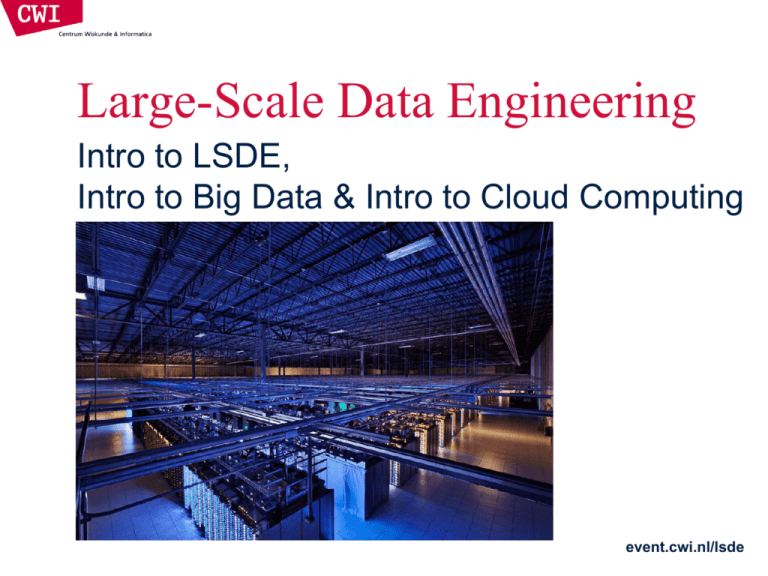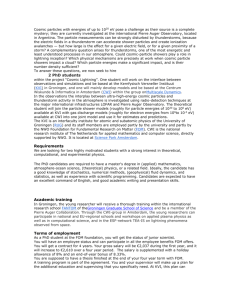Course Introduction
advertisement

Large-Scale Data Engineering
Intro to LSDE,
Intro to Big Data & Intro to Cloud Computing
event.cwi.nl/lsde
Administration
• Blackboard Page
– Announcements, also via email (pardon html formatting)
– Turning in practicum assignments, Check Grades
• Contact: Email & Skype lsde_course@outlook.com
www.cwi.nl/~boncz/bads
event.cwi.nl/lsde
Goals & Scope
• The goal of the course is to gain insight into and experience in using hardware
infrastructures and software technologies for analyzing ‘big data’.
This course delves into the practical/technical side of data science
understanding and using large-scale data engineering to analyze big data
www.cwi.nl/~boncz/bads
event.cwi.nl/lsde
Goals & Scope
• The goal of the course is to gain insight into and experience in using
hardware infrastructures and software technologies for analyzing ‘big data’.
Confronting you with the problems
method: struggle with assignment 1
• Confronts you with some data management tasks, where
– naïve solutions break down
– problem size/complexity requires using a cluster
• Solving such tasks requires
– insight in the main factors that underlie algorithm performance
• access pattern, hardware latency/bandwidth
– these factors guided the design of current Big Data infratructures
• helps understanding the challenges
www.cwi.nl/~boncz/bads
event.cwi.nl/lsde
Goals & Scope
• The goal of the course is to gain insight into and experience in using hardware
infrastructures and software technologies for analyzing ‘big data’.
Learn technical material about large-scale data engineering
material: slides, scientific papers, books, videos, magazine articles
• Understanding the concepts
hardware
– What components are hardware infrastructures made up of?
– What are the properties of these hardware components?
– What does it take to access such hardware?
software
– What software layers are used to handle Big Data?
– What are the principles behind this software?
– Which kind of software would one use for which data problem?
www.cwi.nl/~boncz/bads
event.cwi.nl/lsde
Goals & Scope
• The goal of the course is to gain insight into and experience in using
hardware infrastructures and software technologies for analyzing ‘big data’.
Obtain practical experience by doing a big data analysis project
method: do this in assignment 2 (+talk +report)
• Analyze a large dataset for a particular question/challenge
• Use the SurfSARA Hadoop cluster (90 machines) and appropriate cluster
software tools
www.cwi.nl/~boncz/bads
event.cwi.nl/lsde
Your Tasks
• Interact in class (always)
• Start working on Assignment 1 (now)
– Form couples via Blackboard
– Implement a ‘query’ program that solves a marketing query over a social
network (and optionally also a ‘reorg’ program to store the data in a more
efficient form).
– Deadline within 2.5 weeks. Submit a *short* PDF report that explains what you
implemented, experiments performed, and your final thoughts.
• Read the papers in the reading list as the topics are covered (from next week on)
• Pick a unique project for Assignment 2 (in 2.5 weeks)
– 20min in-class presentation of your papers (last two weeks of lectures)
• We can give presentation feedback beforehand (submit slides 24h earlier)
– Conduct the project on a Hadoop Cluster (DAS-4 or SurfSARA)
• write code, perform experiments
– Submit a Project Report (deadline wk 13)
• Related work (papers summary), Main Questions, Project Description,
Project Results, Conclusion
www.cwi.nl/~boncz/bads
event.cwi.nl/lsde
The age of Big Data
• An internet minute
1500TB/min =
1000 full drives
per minute
= a stack of
20meter high
4000 million
TeraBytes
=
3 billion
full disk drives
www.cwi.nl/~boncz/bads
event.cwi.nl/lsde
“Big Data”
www.cwi.nl/~boncz/bads
event.cwi.nl/lsde
The Data Economy
www.cwi.nl/~boncz/bads
event.cwi.nl/lsde
Disruptions by the Data Economy
www.cwi.nl/~boncz/bads
event.cwi.nl/lsde
Data Disrupting Science
Scientific paradigms:
1.
Observing
2.
Modeling
3.
Simulating
4.
Collecting and Analyzing Data
www.cwi.nl/~boncz/bads
event.cwi.nl/lsde
Data Driven Science
raw data rate
30GB/sec
per station
=
1 full disk drive
per second
www.cwi.nl/~boncz/bads
event.cwi.nl/lsde
Big Data
• Big Data is a relative term
– If things are breaking, you have Big Data
– Big Data is not always Petabytes in size
– Big Data for Informatics is not the same as for Google
• Big Data is often hard to understand
– A model explaining it might be as complicated as the data itself
– This has implications for Science
• The game may be the same, but the rules are completely different
– What used to work needs to be reinvented in a different context
www.cwi.nl/~boncz/bads
event.cwi.nl/lsde
Big Data Challenges (1/3)
• Volume data larger than a single machine (CPU,RAM,disk)
– Infrastructures and techniques that scale by using more machines
– Google led the way in mastering “cluster data processing”
• Velocity
• Variety
www.cwi.nl/~boncz/bads
event.cwi.nl/lsde
Supercomputers?
• Take the top two supercomputers in the world today
– Tiahne-2 (Guangzhou, China)
• Cost: US$390 million
– Titan (Oak Ridge National Laboratory, US)
• Cost: US$97 million
• Assume an expected lifetime of five years and compute cost per hour
– Tiahne-2: US$8,220
– Titan: US$2,214
• This is just for the machine showing up at the door
– Not factored in operational costs (e.g., running, maintenance, power,
etc.)
www.cwi.nl/~boncz/bads
event.cwi.nl/lsde
Let’s rent a supercomputer for an hour!
• Amazon Web Services charge US$1.60 per hour for a large instance
– An 880 large instance cluster would cost US$1,408
– Data costs US$0.15 per GB to upload
• Assume we want to upload 1TB
• This would cost US$153
– The resulting setup would be #146 in the world's top-500 machines
– Total cost: US$1,561 per hour
– Search for (first hit): LINPACK 880 server
www.cwi.nl/~boncz/bads
event.cwi.nl/lsde
Supercomputing vs Cluster Computing
• Supercomputing
– Focus on performance (biggest, fastest).. At any cost!
• Oriented towards the [secret] government sector / scientific computing
– Programming effort seems less relevant
• Fortran + MPI: months do develop and debug programs
• GPU, i.e. computing with graphics cards
• FPGA, i.e. casting computation in hardware circuits
– Assumes high-quality stable hardware
• Cluster Computing
– use a network of many computers to create a ‘supercomputer’
– oriented towards business applications
– use cheap servers (or even desktops), unreliable hardware
• software must make the unreliable parts reliable
– focus on economics (bang for the buck)
• programming effort counts, a lot! No time to lose on debugging..
www.cwi.nl/~boncz/bads
event.cwi.nl/lsde
Cloud Computing vs Cluster Computing
• Cluster Computing
– Solving large tasks with more than one machine
• Parallel database systems (e.g. Teradata, Vertica)
• noSQL systems
• Hadoop / MapReduce
• Cloud Computing
www.cwi.nl/~boncz/bads
event.cwi.nl/lsde
Cloud Computing vs Cluster Computing
• Cluster Computing
• Cloud Computing
– Machines operated by a third party in large data centers
• sysadmin, electricity, backup, maintenance externalized
– Rent access by the hour
• Renting machines (Linux boxes): Infrastructure as a Service
• Renting systems (Redshift SQL): Platform-as-a-service
• Renting an software solution (Salesforce): Software-as-a-service
• {Cloud,Cluster} are independent concepts, but they are often combined!
– We will do so in the practicum (Hadoop on Amazon Web Services)
www.cwi.nl/~boncz/bads
event.cwi.nl/lsde
Economics of Cloud Computing
• A major argument for Cloud Computing is pricing:
– We could own our machines
• … and pay for electricity, cooling, operators
• …and allocate enough capacity to deal with peak demand
– Since machines rarely operate at more than 30% capacity, we are
paying for wasted resources
• Pay-as-you-go rental model
– Rent machine instances by the hour
– Pay for storage by space/month
– Pay for bandwidth by space/hour
• No other costs
• This makes computing a commodity
– Just like other commodity services (sewage, electricity etc.)
www.cwi.nl/~boncz/bads
event.cwi.nl/lsde
Cloud Computing: Provisioning
• We can quickly scale resources
as demand dictates
– High demand: more instances
– Low demand: fewer instances
• Elastic provisioning is crucial
• Target (US retailer) uses Amazon
Web Services (AWS) to host
target.com
– During massive spikes
(November 28 2009 –''Black
Friday'') target.com is
unavailable
• Remember your panic when
Facebook was down?
demand
underprovisioning
provisioning
overprovisioning
time
www.cwi.nl/~boncz/bads
event.cwi.nl/lsde
Cloud Computing: some rough edges
• Some provider hosts our data
– But we can only access it using proprietary (non-standard) APIs
– Lock-in makes customers vulnerable to price increases and dependent
upon the provider
– Local laws (e.g. privacy) might prohibit externalizing data processing
• Providers may control our data in unexpected ways:
– July 2009: Amazon remotely remove books from Kindles
– Twitter prevents exporting tweets more than 3200 posts back
– Facebook locks user-data in
– Paying customers forced off Picasa towards Google Plus
• Anti-terror laws mean that providers have to grant access to governments
– This privilege can be overused
www.cwi.nl/~boncz/bads
event.cwi.nl/lsde
Privacy and security
• People will not use Cloud Computing if trust is eroded
– Who can access it?
• Governments? Other people?
• Snowden is the Chernobyl of Big Data
– Privacy guarantees needs to be clearly stated and kept-to
• Privacy breaches
– Numerous examples of Web mail accounts hacked
– Many many cases of (UK) governmental data loss
– TJX Companies Inc. (2007): 45 million credit and debit card numbers
stolen
– Every day there seems to be another instance of private data being
leaked to the public
www.cwi.nl/~boncz/bads
event.cwi.nl/lsde
Big Data Challenges (2/3)
• Volume
• Velocity endless stream of new events
– No time for heavy indexing (new data keeps arriving always)
– led to development of data stream technologies
• Variety
www.cwi.nl/~boncz/bads
event.cwi.nl/lsde
Big Streaming Data
• Storing it is not really a problem: disk space is cheap
• Efficiently accessing it and deriving results can be hard
• Visualising it can be next to impossible
• Repeated observations
– What makes Big Data big are repeated observations
– Mobile phones report their locations every 15 seconds
– People post on Twitter > 100 million posts a day
– The Web changes every day
– Potentially we need unbounded resources
• Repeated observations motivates streaming algorithms
www.cwi.nl/~boncz/bads
event.cwi.nl/lsde
Big Data Challenges (3/3)
• Volume
• Velocity
• Variety Dirty, incomplete, inconclusive data (e.g. text in tweets)
– Semantic complications:
• AI techniques needed, not just database queries
• Data mining, Data cleaning, text analysis (AI techniques)
– Technical complications:
• Skewed Value Distributions and “Power Laws”
• Complex Graph Structures Expensive Random Access
• Complicates cluster data processing (difficult to partition equally)
• Localizing data by attaching pieces where you need them makes Big Data
even bigger
www.cwi.nl/~boncz/bads
event.cwi.nl/lsde
Power laws
• This is not the 80/20 rule of skewed data (“80% of the sales are the 20% of the products”)
– In a power law distribution, 80% of the data sales could well be in the “long tail” (the
model is as large as the data).
• Modelling the head is easy, but may not be representative of the full population
– Dealing with the full population might imply Big Data (e.g., selling all books, not just
block busters)
• Processing Big Data might reveal power-laws
– Most items take a small amount of time to process, individually
– But there may be very many relevant items (“products”) to keep track of
– A few items take a lot of time to process
www.cwi.nl/~boncz/bads
event.cwi.nl/lsde
Skewed Data
• Distributed computation is a natural way to tackle Big Data
– MapReduce encourages sequential, disk-based, localised processing
of data
– MapReduce operates over a cluster of machines
• One consequence of power laws is uneven allocation of data to nodes
– The head might go to one or two nodes
– The tail would spread over all other nodes
– All workers on the tail would finish quickly.
– The head workers would be a lot slower
• Power laws can turn parallel algorithms into sequential algorithms
www.cwi.nl/~boncz/bads
event.cwi.nl/lsde
Big Data Challenges (3/3)
• Volume
• Velocity
• Variety Dirty, incomplete, inconclusive data (e.g. text in tweets)
– Semantic complications:
• AI techniques needed, not just database queries
• Data mining, Data cleaning, text analysis (AI techniques)
– Technical complications:
• Skewed Value Distributions and “Power Laws”
• Complex Graph Structures Expensive Random Access
• Complicates cluster data processing (difficult to partition equally)
• Localizing data by attaching pieces where you need them makes Big Data
even bigger
www.cwi.nl/~boncz/bads
event.cwi.nl/lsde
Summary
• Introduced the notion of Big Data, the three V’s
– Volume, Velocity, Variety
• Explained differences between Super/Cluster/Cloud computing
Cloud computing:
• Computing as a commodity is likely to increase over time
• Cloud Computing adaptation and adoption are driven by economics
• The risks and obstacles behind it are complex
• Three levels:
– Infrastructure as a service (run machines)
– Platform as a service (use a database system on the cloud)
– Software as a service (use software managed by other on the cloud)
www.cwi.nl/~boncz/bads
event.cwi.nl/lsde





